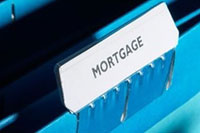| Download Buyers Guide PDF (English) | |
| Descargar Manual Del Comprador PDF (Espanol) | Pages: 1 2 3 4 5 6 |
Glossary of Terms (continued)
Mortgage Insurance
 Money paid to insure the mortgage when the down payment is less than 20%. See Private Mortgage Insurance or FHA Mortgage Insurance.
Money paid to insure the mortgage when the down payment is less than 20%. See Private Mortgage Insurance or FHA Mortgage Insurance.
Negative Amortization
Negative amortization occurs when the monthly payments are not large enough to pay all of the unpaid balance of the loan, therefore increasing the loan balance and going in a "negative" direction. In this particular scenario, a borrower can literally end up owing more money than they originally borrowed. The reason that this occurs is because on a negatively amortized loan, the borrower is given several different payment options.
OPTION 1: To pay what is known as the fully indexed payment. This is the margin plus index on the adjustable. This payment, which is typically the highest of the options, will prevent you from going negative.
OPTION 2: An interest only payment. You would not be going negative by making this payment either, but you would not be decreasing the principal balance that you owe on your loan. This is because you are paying only the interest portion and no additional principal to your loan.
OPTION 3: (And the one that most often gets people into trouble...) The negatively amortized payment. This is a payment that not only does not cover the principal, but doesn't cover all of the interest owed on the monthly payment, therefore accruing negative equity as a result.
Origination Fee
 The fee charged by the lender for issuing a loan; usually computed as a percentage of face value of the loan.
The fee charged by the lender for issuing a loan; usually computed as a percentage of face value of the loan.
PITI
Also known as monthly housing expense, this is the principal, interest, taxes and insurance.
Piggy Back Loan
"Piggy Back Loan" is a slang term, which really is another way of describing a 1st and 2nd mortgage that close concurrently at the funding of a loan. This combination of a 1st and 2nd mortgage can be effectively utilized to avoid the need to pay private mortgage insurance. The borrower may apply for a loan at 90% with the same 10% down payment. A 1st mortgage at 80% and a 2nd mortgage at 10% could be procured concurrently. The interest rate on the 2nd mortgage is typically a higher rate that can be a double?digit figure. However, the fact that the interest can be deducted on the 2nd mortgage often makes this a prudent financial option for the borrower if the lender allows a 2nd mortgage. The net result is often cheaper than borrowing 90% of the financing as one loan and incurring a private mortgage insurance payment. However, you may want to seek the advice of an accountant as to which option is best for your needs. See Private Mortgage Insurance.
Pre-payment Penalty
Money charged for an early repayment of debt. Pre?payment penalties are allowed in some form (but not necessarily imposed) in most states in the US, as well as the District of Columbia.
Private Mortgage Insurance (PMI)
 In the event that you do not have a 20% down payment, the lender will allow a smaller down payment. However, with a smaller down payment, borrowers are usually required to carry private mortgage insurance on the loan. Speak with a trusted mortgage specialist for specific examples.
In the event that you do not have a 20% down payment, the lender will allow a smaller down payment. However, with a smaller down payment, borrowers are usually required to carry private mortgage insurance on the loan. Speak with a trusted mortgage specialist for specific examples.
Title Insurance
A policy usually issued by a title insurance company, which insures a home buyer against errors in the title search. The cost of the policy is usually a function of the value of the property, and is often borne by the purchaser and/or seller.
Underwriting
Provides (or declines) funding to potential home buyers, based upon factors such as credit, employment, assets, etc., and matches approved risks with appropriate rates, terms and loan amounts.
| Pages: 1 2 3 4 5 6 |











